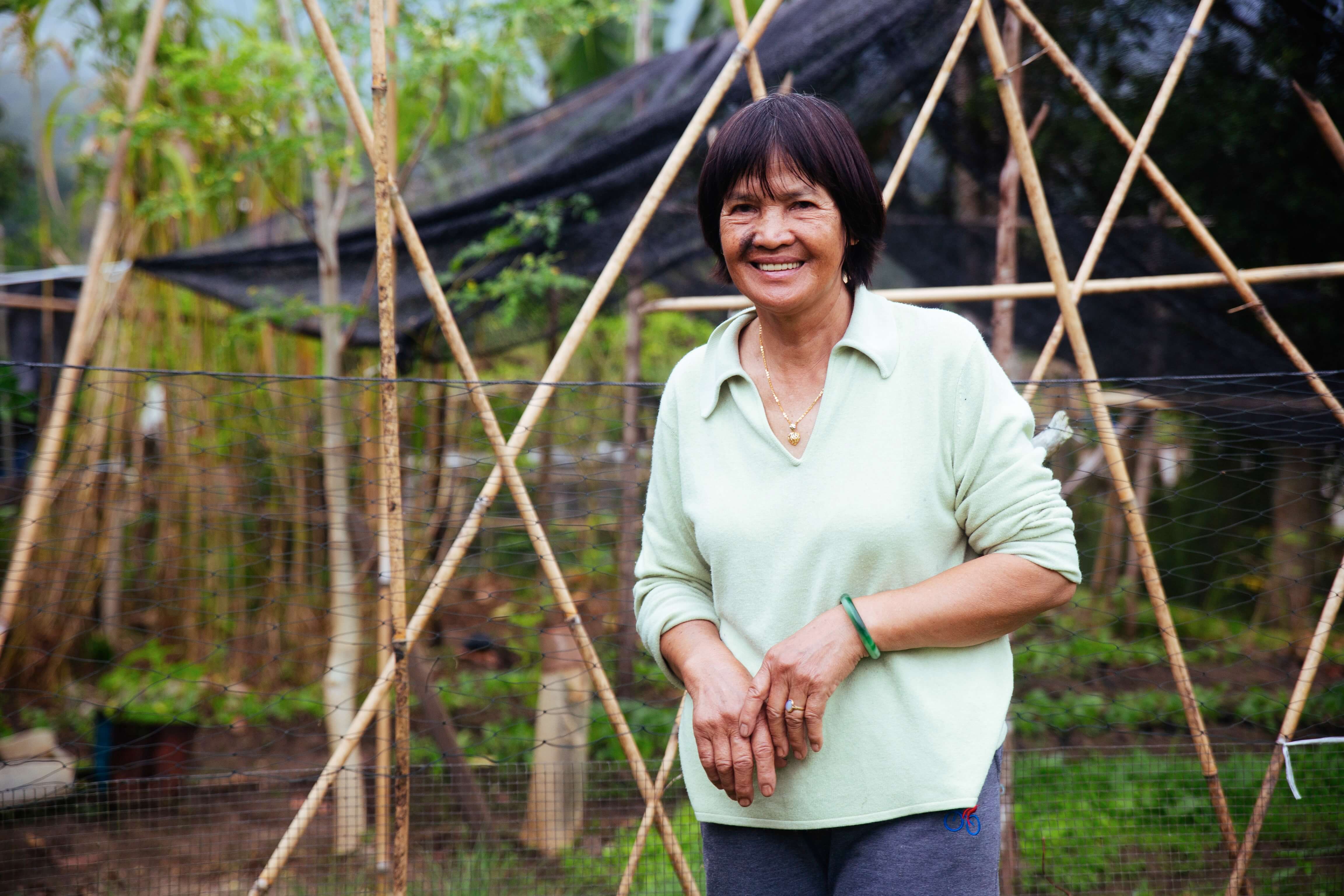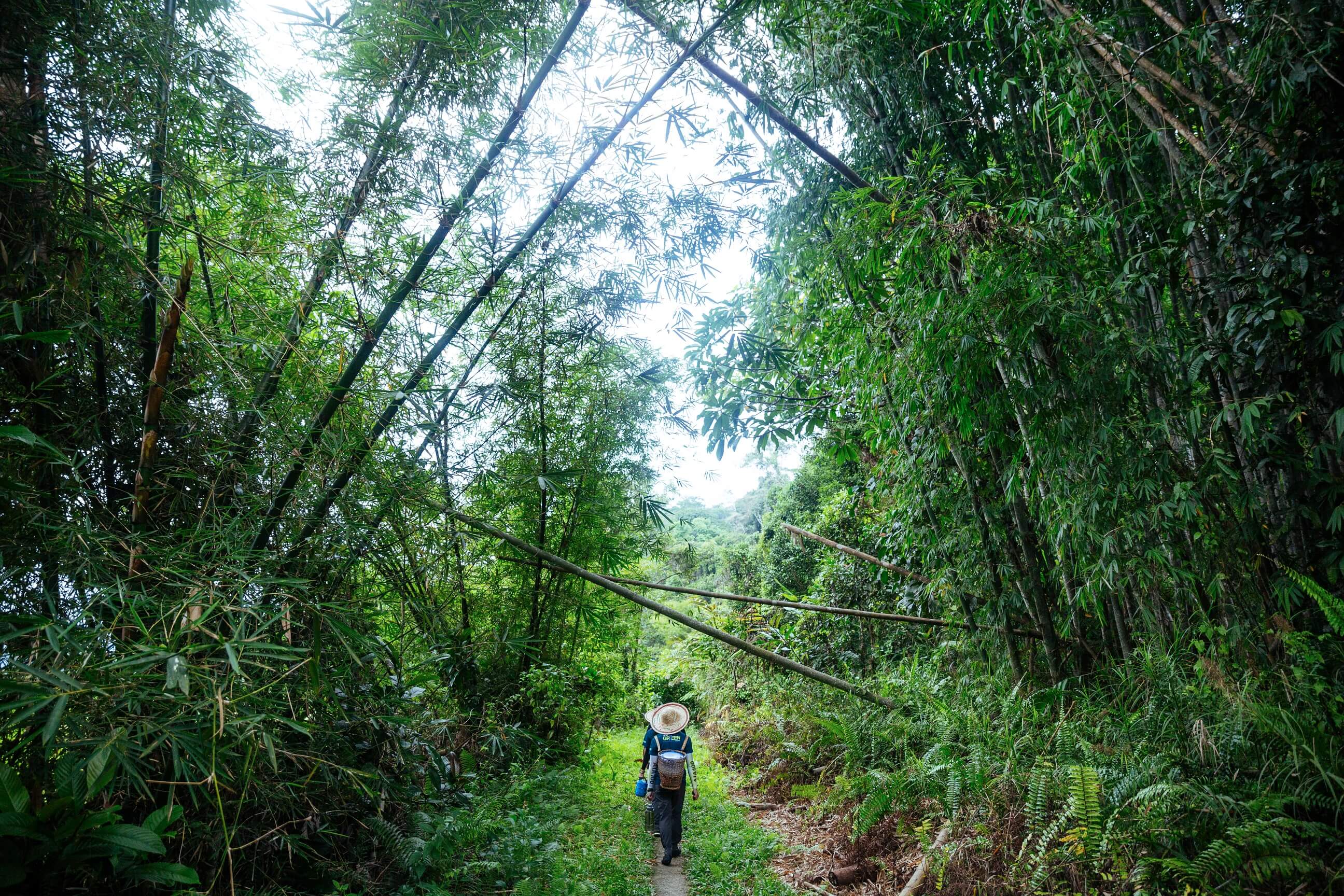With Langit Collective, farm-to-table is no mere fashionable dining concept — it is a movement that empowers one of the world’s most remote farming communities. Travel with Langit to beautiful Long Semadoh for a taste of not only some of the world’s most amazing rice, but also the culture behind every bite.
MEET AUNTY RIBED

Only half an hour in, and my back is screaming.
Wiping away the sweat dribbling down my face, I cast an admiring glance at Aunty Ribed’s fast, steady movements. She has been working at the rice field since dawn, yet she’s barely breaking a sweat. And she’s 20 years my senior.
Ruefully, I return my attention to the bunch of seedlings in my hands, only to lose balance and fall backwards into the quicksand-like mud — for the third time. My clothes (as well as my face) are completely soiled. I know I am a comical sight, but I am reluctant to get up. Wrapped in the cooling thick mud, surrounded by sweeping paddy fields and the most amazing mountain views, this feels like a mud spa, only a million times nicer.
Maybe being a rice farmer isn’t my life calling. But for a spell, it sure is fun.
LONG SEMADOH - LOST TO THE WORLD
Hapless visitors like myself can now try their hand at rice farming thanks to Langit Collective, a social enterprise that partners with communities in Long Semadoh to offer an experiential tour and homestay.
Never heard of Long Semadoh? You’re not alone. The forest-covered East Malaysian state of Sarawak is full of unexplored raw gems and Long Semadoh valley is unknown even to seasoned travellers like myself.
Snaking across the Lawas Highlands at 3,000ft above sea level, Long Semadoh valley is a strip of seven quaint villages populated predominantly by Lun Bawang, an indigenous tribe of hunter-gatherers turned agrarians. Nourished by crisp mountain air, pristine streams and a temperate climate, Long Semadoh is home to some of the world’s best produce, notably heirloom rice varietals unique to this region.
While ideal for agriculture and country life, Long Semadoh’s remoteness leaves the community disadvantaged in other ways. Out of seven villages in the valley, only three have electricity. The main form of communication is walkie-talkie because phone connectivity is spotty. Internet is practically non-existent.
Getting to Long Semadoh from Kuala Lumpur involves two plane rides and a bumpy four-hour 4WD drive up a landslide-prone logging trail that once prompted a visitor to ask: “Is it a road or buffalo trail?”
ENTER LANGIT COLLECTIVE

Langit’s story began when Lilian Chen, Chan Zi Xiang, Melisa Lim and Chia Yong Ling — a chiropractor, actuary, media producer and designer respectively — were building gravity-fed water systems in rural Sarawak. They got to know the folks of Long Semadoh — as well as their amazing rice.
“With its bold earthy flavours and distinctive bite, it was the best rice we’d eaten in our lives!” exclaims Lilian. “When we told them we couldn’t finish all that rice, they said, ‘Never mind, we will feed it to our chickens and dogs.’
“We were horrified! Digging deeper, we realised the farmers couldn’t convert their excess rice into income because of their remote location.”
Long Semadoh farmers have to fork out large sums of money to transport both themselves as well as their rice to Lawas, the nearest town. “Once we get there, we have to compete with other rice producers, for a pittance in return,” says Aunty Ribed. “And the road to Lawas was teruk (terrible). If it rains, the 4WD vehicle gets stuck in the mud and passengers have to get down and push it.”
With dismal economic prospects, the younger generation have been forced to abandon their homes to work in the cities, leaving the farms to the care of their elders, but this leads to a catch-22. “Youths from rural villages do not necessarily have the social capital or competitiveness of an urban person, so they end up working odd jobs,” observes Lilian.
To break this vicious cycle, the four friends created Langit Collective. The social enterprise buys the Long Semadoh farmers’ excess rice at a fair price and sells it on their online platform, and to retailers and chefs in Peninsular Malaysia.
Thirty-five per cent of the retail proceeds go to the farmers. After deducting costs, the remainder is re-invested into capacity-building courses for the farmers, especially in sustainable farming, to meet the demand for organic rice.
Additional jobs are created along the supply chain. Once the rice is harvested, local transporters hired by Langit pick up the rice from the farmers’ doorsteps and bring the produce to town, where local women vacuum-pack the products before they are shipped to Peninsular Malaysia.
Langit’s work has seen success. But the founders thought the enterprise could go further — through an experiential tour providing curiosity-seekers the opportunity to shadow traditional rice farmers in an authentic community, while instilling a sense of pride in the Long Semadoh folks.
And so, Langit Experience was born.
A FORGOTTEN CULTURE

Depending on the time of the year, you can sign up to experience rice planting or rice harvesting (and of course eating it together with delicious home-cooked Lun Bawang meals) with the Langit team as your guides.
Though rice farming is a significant part of the trips, you will also be able to explore the village and get to know Long Semadoh’s history while basking in its natural beauty.
In the wake of British colonisation at the turn of the 20th century, Christianity brought gentrification and town planning into the Lun Bawang community, who had already moved out of traditional longhouses into concrete and wooden houses.
But in the process, many Lun Bawang beliefs and traditions became lost. “Some of the older generation see pre-Christianity activities such as head-hunting as something to be ashamed of. I feel it’s a pity, because it’s part of their history,” says Zi, one of the Langit founders.
Langit has tried to bring what little cultural information they have unearthed into the experiential tour. A day before we hit the fields, we go on a leisurely “kampung (village) tour” that includes a trek past an old airport field leading to a former buaya tanah (crocodile mound), where Lun Bawang warriors celebrated for seven days and nights after a successful headhunting expedition.
A scenic hanging bridge takes us to possibly the only existing Lun Bawang animistic cemetery, where a pile of human skulls and ancestral jars lies under a giant tree.
Along the way, Zi and Lilian entertain us with tales of Lun Bawang mythical figures such as Upai Semaring, a giant who could cross a nearby river in a single bound. From their passion and enthusiasm, it is clear to me how Langit’s investment in Long Semadoh is more than just business. In fact, the founders have their own Lun Bawang names: Gituen (Lilian), Aco (Zi), Bulan (Melisa) and Udan (Yong Ling).
PLAYING FARMER

After the history lesson, it’s time to get down and dirty.
From the back of Aunty Ribed’s house, we make our way to the fields dressed in long-sleeved shirts, long pants tucked into football socks, rubber shoes and wide-brimmed hats. The coverage is necessary to avoid sunburn and chafing from tall rushes.
Following Aunty’s lead, we wade into the muddy paddock and pull out the seedlings that were planted here. We transport the seedlings on a wheelbarrow to another field, where the real work begins: bending at the waist to stick the seedlings into the muddy earth.
The fields have been “fertilised” by buffaloes: After each harvest, water buffaloes are released to the paddy fields to graze on rice stumps and weeds and clear it for the next planting season. They also help to fertilise the fields – by pooping.
Unlike us, the buffalo have done their job, and have ambled off to escape the sun. “Buffaloes have the best life in Long Semadoh. They literally just poop, eat and siesta!” exclaims Lilian.
As we work side by side, Aunty shares her knowledge of birds and insects which control pest invasions and diseases, stresses the importance of fallow periods — letting land recover between cultivation — and crop rotation to continue the fertility of the land, and shows us a primitive yet efficient irrigation system that connects all the paddy fields.
She may not use any high-tech equipment or fancy terms, but in my opinion, she is as good as any scientist.
It is twilight by the time we get back to the house for dinner. A true farm-to-table feast whipped up by resident chef Zi awaits us: kung pow “escargot” from snails caught from the paddy fields, scrambled eggs with brinjals from the forest, curry chicken made from birds that Aunty reared herself, and for dessert, “sorbet” made from blended local pineapples.
They are all delicious, but our unanimous favourite is the humble rice that has transformed our perspective forever.
FOOD FOR THOUGHT
I opt out of paddy planting the next day, leaving my fitter compatriots to contribute their brawn. This is not a boot camp; you’re free to experience the activities at your own pace.
Finding a cool spot under a tree, I take a moment to contemplate the misty mountains in the distance, and the fertile fields all around me. The poetic setting would make a great yoga or writer’s retreat, but there are no tourists here other than us.
My eyes fall on Aunty Ribed. Spending time with her has taught me that to grow things that nourish, one needs patience; nothing comes easy. She understands the frailty of life, the rewards of hard work and the humility to accept what she cannot control.
There is so much we can learn from the farmers of Long Semadoh — rice is only the beginning.
Langit Collective is among the alumni of the Young Social Entrepreneur (YSE) programme by Singapore International Foundation, which provides mentorship, networking opportunities and a grant. In 2019, it landed the DBSF x SIF Social Impact Prize which is given out to YSE alumni who have shown sustained achievements after the programme.
































